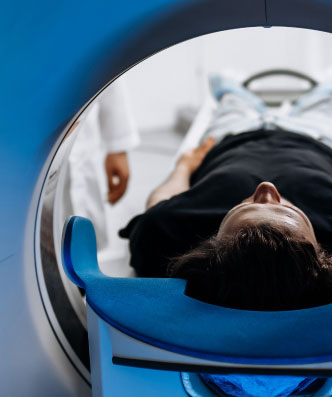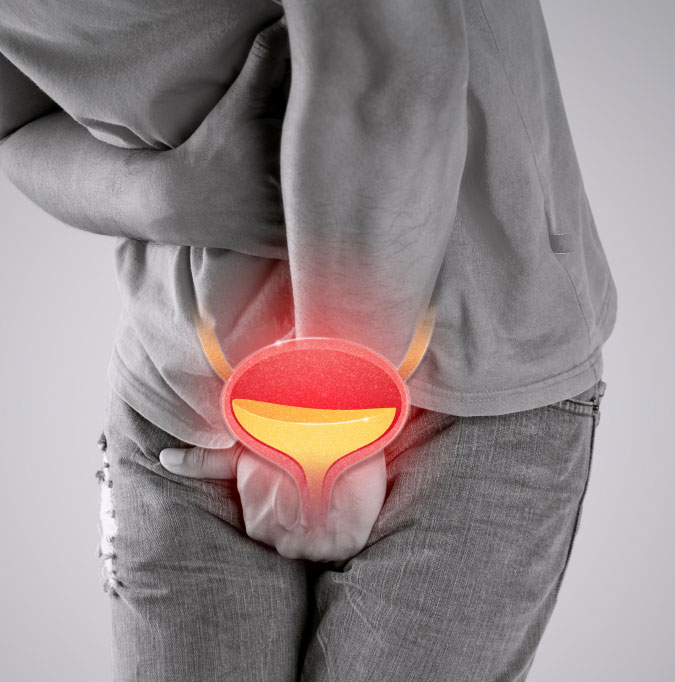Bladder Cancer
Treatment in
Singapore
Minimally Invasive
Compassionate

of Experience



Care & Support
Bladder cancer can be effectively treated when identified early.

What Is Bladder Cancer?
Bladder cancer occurs when abnormal cells grow uncontrollably in the bladder lining. The most common type is urothelial carcinoma (also known as transitional cell carcinoma), which accounts for over 90% of bladder cancers in Singapore.
Bladder cancer is classified as:
- Non-muscle Invasive Bladder Cancer (NMIBC) – This is confined to the inner lining
- Muscle-invasive Bladder Cancer (MIBC) – This has invaded the muscular layer
- Metastatic Bladder Cancer – This has spread to distant organs
The type and stage determine how bladder cancer is treated and monitored.
What are the Symptoms of Bladder Cancer?
The most common and often earliest symptom of bladder cancer is blood in the urine (known as haematuria). It may appear pink, red, or brown and can occur intermittently.
Other signs of bladder cancer include:
- Pain or burning during urination
- Frequent or urgent need to urinate
- Difficulty passing urine or weak urine stream
- Pelvic pain or discomfort
- Lower back pain on one side (in advanced cases)
These symptoms can overlap with other urinary tract conditions, such as infections or bladder stones, so it’s important to get evaluated by a urologist.

Prompt diagnosis and intervention leads to better outcomes.

Who Is at Risk of Bladder Cancer?
Risk factors for bladder cancer include:
- Smoking – The biggest preventable risk factor
- Age – Most common in people over 55
- Exposure to Industrial Chemicals (e.g., in dye, rubber, textile industries)
- Chronic Bladder Irritation (e.g., due to long-term catheter use or infections)
- Previous Cancer Treatments – Such as chemotherapy or pelvic radiation
- Family History of Bladder Cancer (Less common)
How Is Bladder Cancer Diagnosed?
If bladder cancer is suspected, your urologist may perform the following:

Urine Cytology
to look for cancer cells in the urine

Flexible Cystoscopy
a thin camera is passed through the urethra to inspect the bladder lining

CT Urogram or MRI
to evaluate the urinary tract and bladder

TURBT (Transurethral Resection of Bladder Tumour)
a key diagnostic and therapeutic procedure to remove the tumour for analysis. Biopsy results from TURBT help confirm the cancer type, grade, and depth of invasion.
Staging and Grading of Bladder Cancer
Bladder cancer is staged based on how deeply it has penetrated the bladder wall and whether it has spread:
STAGE 0
Non-invasive; confined to the surface (papillary tumour or carcinoma in situ)
STAGE 1
Spread into connective tissue layer
STAGE 2
Spread into the muscle layer
STAGE 3
Spread beyond the bladder to nearby tissue
STAGE 4
Spread to lymph nodes or distant organs
Tumours are also graded (low or high) based on how aggressive they appear under the microscope.
What are the Treatments for Bladder Cancer in Singapore?
Treatment will depend on the stage, grade, and number of tumours present.
Non-Muscle Invasive Bladder Cancer (NMIBC)
This is most common in early-stage cases, where the cancer has not spread into the bladder muscle.
- TURBT (Transurethral Resection of Bladder Tumour):
A minimally invasive procedure where visible tumours are removed from the bladder lining using a scope passed through the urethra. This is often the first-line treatment. - Intravesical Therapy:
Medication is placed directly into the bladder via a catheter to reduce the risk of recurrence. This may include:- BCG (Bacillus Calmette–Guérin) immunotherapy: A live bacterial solution that stimulates the immune system to attack cancer cells.
- Intravesical chemotherapy: Anti-cancer drugs delivered locally to destroy residual tumour cells and prevent regrowth.
- BCG (Bacillus Calmette–Guérin) immunotherapy: A live bacterial solution that stimulates the immune system to attack cancer cells.
- Surveillance Cystoscopy:
Regular follow-up using a small camera inserted into the bladder to detect early signs of recurrence or new tumour growth.


Muscle-Invasive or Advanced Bladder Cancer
This is when cancer has spread into the muscle layer of the bladder or beyond.
- Radical Cystectomy:
Surgical removal of the entire bladder, often including surrounding tissues. The procedure typically requires a urinary diversion to replace the bladder, such as an ileal conduit (a stoma opening onto the abdominal wall for urine to drain out) or a neobladder (a piece of small intestine is harvested and reconstructed to form the ‘new’ bladder). - Systemic Chemotherapy:
Anti-cancer drugs administered through the bloodstream to target cancer cells throughout the body. Often used before surgery (neoadjuvant) to shrink tumours, or after surgery (adjuvant) to lower recurrence risk. - Radiation Therapy:
High-energy rays are used to destroy cancer cells. May be considered as an alternative to surgery in selected patients or combined with chemotherapy for bladder preservation. - Bladder Preservation Strategies:
A non-surgical approach for certain patients involving a combination of TURBT, chemotherapy, and radiation to treat the tumour while keeping the bladder intact.
When to See a Urologist for Suspected Bladder Cancer
You should see a urologist if you notice:
- Blood in your urine (even once)
- Persistent urinary urgency, frequency, or pain
- Recurrent urinary tract infections without a clear cause
- History of smoking or occupational exposure to chemicals
Bladder cancer detected early can often be treated with better outcomes.


Our Bladder Cancer Specialist
Dr Tan Teck Wei
MBBS (S’pore), DFD (CAW), MRCS (Edin),MMed (Surgery), FAMS (Urology)
Dr Tan Teck Wei is a Senior Consultant Urologist and former Director of Genitourinary Oncology at Tan Tock Seng Hospital. Skilled in the management of bladder cancer, Dr Tan strives to provide empathetic and effective care with the patient’s best interests in mind. He is fellowship-trained in open, laparoscopic and robotic urologic surgery; and has held numerous leadership and academic positions. Dr Tan understands the distress faced by patients and their families, and is committed to providing care that is not only medically sound but also supportive, personalised, and attuned to each patient’s circumstances.
FAQs on Bladder Cancer
Blood in the urine (haematuria), either visible or microscopic, is the most common early sign of bladder cancer.
Yes. Many cases, especially non-invasive bladder cancers, can be managed effectively with endoscopic surgery and intravesical therapy.
The biggest risk factor is smoking. Exposure to certain industrial chemicals can also increase one’s risk.
Patients typically undergo regular cystoscopy, urine tests, and imaging to check for recurrence.
Yes, recurrence is common, especially for non-muscle invasive types, which is why long-term surveillance is essential.
For enquiries on your condition or appointment booking, please fill in the enquiry form and we will be in touch with you soon. Your health and well-being are our top priorities, and we look forward to assisting you on your medical journey.



